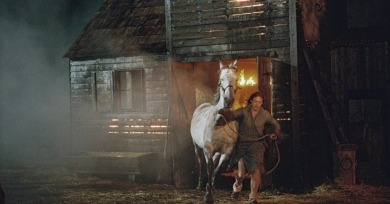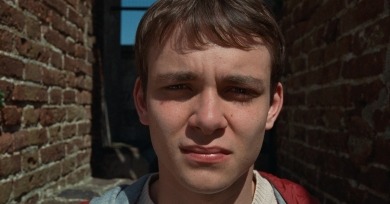Reviews
Anyone privileged enough not to work in the public-facing service economy was compelled to generate new at-home routines during the early days of COVID. More so than its (scant few) pandemic-set contemporaries, Suspended Time acutely understands how previously occupied mental space in adults became vacant for the first time.
The making of the play provides the dramatic scaffolding for the unfolding of life, but both the skit and the college life that surrounds it are presented as spontaneous, oblique, and devastating in their elisions.
Her first English-language feature, the film relinquishes some of Athina Rachel Tsangari’s steadily calamitous humor and Greek locales, while preserving her institutional critiques of capitalism and chauvinism.
Diciannove, the first film by Giovanni Tortorici, who is not yet out his twenties, speaks to the psychic undercurrents of our fresh Hell, while also carrying on a dialogue with the traditions of European romanticism in literature and film.
Like Pulse, the film’s conceit imagines a nightmare scenario in which an aspect of technologically modulated human interaction—here, online harassment—breaches the borders of reality.
Cohen suggests that modern cinema, unshackled from genre, is more powerful than we may give it credit for. His work is porous, holding room for all these possibilities and more.
Don’t Let’s Go to the Dogs Tonight is a passion project of the best kind, and not just because it features a part actors would give their right arm to play.
In case you did not see the other two films, 28 Years Later provides a quick refresher. Serving as audience surrogates, a living-room gathering of increasingly anxious children watch Teletubbies while all hell breaks loose outside. Only one of them makes it out alive.
Uninterested in proffering any moral judgments on bullfighting as a tradition, Serra instead investigates the perceptual, bodily specifics through which such a practice is both produced and sustained.
Familiar Touch, the debut narrative feature from Sarah Friedland about an octogenarian woman entering a full-time memory care facility, exists along the edges of the coming-of-age film. Ruth (Kathleen Chalfant), a chic Southern Californian, must manage new and pre-existing relationships within her changing circumstances and state-of-mind.
Jonathan Millet has crafted a humanist spy thriller set amid the lingering memories of the Syrian civil war and the atrocities perpetrated by Bashar al-Assad’s regime that is both satisfyingly tense and gently hopeful.
Rather than see the film as a tentative foray into fiction, it may be more useful to consider The Damned as a film that explores how one might have gone about making a documentary during the Civil War.
Yamanaka has made two features to date, along with a few shorts and some contributions to television programs, yet her body of work already contains enough formal gambits and tonal shifts that one might expect from a significantly more experienced filmmaker.













